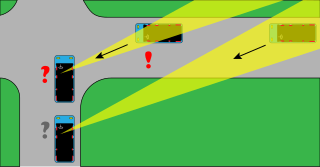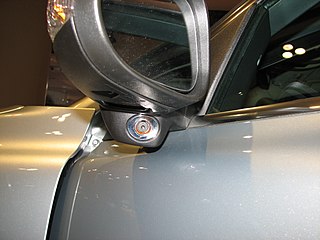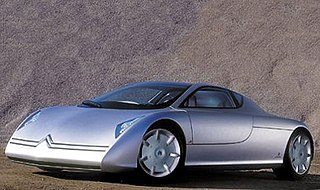
Volvo Cars is a Swedish multinational manufacturer of luxury vehicles headquartered in Torslanda, Gothenburg. The company manufactures SUVs, station wagons, and sedans. The company's main marketing arguments are safety and its Swedish heritage and design.

The Volvo S60 is a compact executive car manufactured and marketed by Volvo since 2000.

A blind spot in a vehicle or vehicle blind spot is an area around the vehicle that cannot be directly seen by the driver while at the controls, under existing circumstances. In transport, driver visibility is the maximum distance at which the driver of a vehicle can see and identify prominent objects around the vehicle. Visibility is primarily determined by weather conditions and by a vehicle's design. The parts of a vehicle that influence visibility include the windshield, the dashboard and the pillars. Good driver visibility is essential to safe road traffic.

The Volvo S80 is an executive car produced by the Swedish manufacturer Volvo Cars from 1998 to 2016 across two generations. It took the place of the rear-wheel-drive S90 as Volvo's flagship sedan.

The Volvo C30 is a three-door, front-engine, front-wheel-drive premium compact hatchback, manufactured and marketed by Volvo Cars from 2006 to 2013, in a single generation. Powered by inline-four and straight-five engines, the C30 is a variant of the Volvo S40/V50/C70 range, sharing the same Ford C1/Volvo P1 platform. Volvo marketed the C30 as a premium hatchback / sports coupe.

In road-transport terminology, a lane departure warning system (LDWS) is a mechanism designed to warn the driver when the vehicle begins to move out of its lane on freeways and arterial roads. These systems are designed to minimize accidents by addressing the main causes of collisions: driver error, distractions and drowsiness. In 2009 the U.S. National Highway Traffic Safety Administration (NHTSA) began studying whether to mandate lane departure warning systems and frontal collision warning systems on automobiles.

The Volvo 440 and 460 are versions of a small family car produced by the Swedish manufacturer Volvo between June 1988 and September 1996. The 440 was a five-door hatchback and the 460 a four-door saloon which followed in 1989. They were built at the NedCar factory in Born, the Netherlands and were only offered with front-wheel drive.

The Volvo VESC, the Volvo Experimental Safety Car, was a concept car made by Volvo to showcase a number of innovative passenger safety features. It was unveiled in 1972 at the Geneva Motor Show.

The Infiniti QX70, formerly called the Infiniti FX until 2013, is a compact luxury crossover SUV produced by the Nissan-owned Infiniti luxury vehicle brand between 2002 and 2017. The FX replaced the QX4 as Infiniti's mid-size SUV. It shares the same FM platform as the rear-wheel drive Nissan 370Z, and it "made no claims of climbing mountains." Rather, its aggressive shape promised style and quick handling. The similarly sized Nissan Murano is based on the same D platform as the front-wheel drive Nissan Altima. The FX does not have a Nissan-branded equivalent and is not sold in Japan.

The Mercedes-Benz W221 is a chassis code of the fifth generation S-Class produced from August 2005 until June 2013. The S-Class are the flagship vehicles of Mercedes-Benz, and each generation typically introduces a range of technical innovations and developments that, over time will find their way into smaller cars.

The Lincoln MKS is a full-sized luxury sedan that was manufactured and marketed by the Lincoln subdivision of Ford from 2008 to 2016. First shown at the LA Auto Show in November 2007, the MKS began production for the 2009 model year at Ford's Chicago Assembly plant in May 2008 with sales beginning a month later. The MKS was the second Lincoln to adopt the "MK" nomenclature and the first model to wear it through its entire production run. With the discontinuation of the Lincoln Town Car in 2011, the MKS at 205.6-inches in length became the longest production sedan sold by an American automaker through 2016.

The blind spot monitor or blind-spot monitoring is a vehicle-based sensor device that detects other vehicles located to the driver’s side and rear. Warnings can be visual, audible, vibrating, or tactile.

The Citroën Osée is a concept car designed by Pininfarina for the French car company Citroën. It was unveiled at the 2001 Geneva Motor Show.

A car door is a type of door opening, typically hinged on its front edge, but sometimes attached by other mechanisms such as tracks, for entering and exiting a vehicle. Doors most often integrate side windows for visibility from inside the car and can be locked to secure the vehicle.

A collision avoidance system (CAS), also known as a pre-crash system, forward collision warning system (FCW), or collision mitigation system, is an advanced driver-assistance system designed to prevent or reduce the severity of a collision. In its basic form, a forward collision warning system monitors a vehicle's speed, the speed of the vehicle in front of it, and the distance between the vehicles, so that it can provide a warning to the driver if the vehicles get too close, potentially helping to avoid a crash. Various technologies and sensors that are used include radar (all-weather) and sometimes laser (LIDAR) and cameras to detect an imminent crash. GPS sensors can detect fixed dangers such as approaching stop signs through a location database. Pedestrian detection can also be a feature of these types of systems.

The Tata Aria is a full-size crossover SUV manufactured by Tata Motors of India. Tata Aria was launched on 5 January 2010 at Auto Expo, Delhi, and was launched to customers on 12 October 2010 and prices started at 10.4 lakhs INR Ex showroom or. It is based upon the Tata Xover concept showcased in the 2006 Geneva Motor Show. Tata Aria was also a series of concept cars introduced by Tata Motors at the Geneva Motor Show in 2000.
The Audi R8 LMS Cup was a one-make sports car racing series by Audi based in Asia. Audi R8 LMS Cup cars were based on the Audi R8 LMS (GT3).

The Volvo EX30 is a battery electric subcompact crossover SUV manufactured by Volvo Cars. Revealed in June 2023, the EX30 is the smallest Volvo vehicle currently on sale, positioned below the XC40 and C40 crossovers. It is produced in China and is related to the Zeekr X and the Smart #1, which are similar in size and developed from Geely's SEA platform. The vehicle will be exported globally.


















